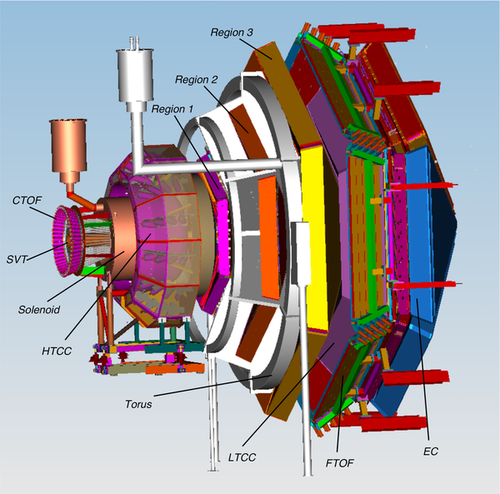Difference between revisions of "Engineering Run"
| Line 88: | Line 88: | ||
* Whenever preparing to receive beam, make sure the following conditions are established: all CLAS12 detectors are off and target is empty. For SVT, MVT, FTH and FTT, turn first HV off and then LV off. For any problem, consult with the expert-on-call. | * Whenever preparing to receive beam, make sure the following conditions are established: all CLAS12 detectors are off and target is empty. For SVT, MVT, FTH and FTT, turn first HV off and then LV off. For any problem, consult with the expert-on-call. | ||
| − | * | + | * Establish beam to the tagger yoke first: |
| + | *# ask MCC to energize the tagger dipole magnet and set the current as needed | ||
| + | for dumping the beam in the designated dump on the tagger yoke. MCC will | ||
| + | ask you to change (set) the beam delivery mode. | ||
| + | *# position the \blank" collimator on the beam (this is a collimator block, 30 cm | ||
| + | long Ni cylinder, without a hole) | ||
| + | *# when the tagger magnet is at required setting ask MCC if they are ready to | ||
| + | deliver beam to the tagger yoke dump (<=5 nA). It may take ~1 hour for MCC to setup and cleanly transport beam to the | ||
| + | tagger yoke dump, | ||
| + | *# perform harp scans using the wire harp at 2C21 girder and 2c24 (tagger harp). Beam profile, peak position, width and signal/background ratio should be like in https://logbooks.jlab.org/entry/3502250 and https://logbooks.jlab.org/entry/3502252. Ask MCC | ||
| + | to retune if needed (e.g. beam is too wide or asymmetric or has large tails), | ||
| + | repeat the scan after every tune. Iterate to get acceptable beam profile. | ||
| + | * send the beam to Faraday Cup dump (otherwise known as electron dump). | ||
| + | #* CLAS12 detectors should be OFF, the solenoid magnet current is at 50% | ||
| + | its max, torus is at 100%. | ||
| + | #* ask MCC to degauss and turn the tagger dipole off; | ||
| + | #* position 20 mm collimator on the beam and move \Chromox" screen of | ||
| + | the downstream viewer in beam position (if it is not already) | ||
| + | |||
** establish beam to the faraday cup: beam current should be 1.5 nA, positions, quads settings and rates should be as in https://logbooks.jlab.org/entry/3502318; | ** establish beam to the faraday cup: beam current should be 1.5 nA, positions, quads settings and rates should be as in https://logbooks.jlab.org/entry/3502318; | ||
** make sure beam is stable and beam spot is clearly visible on the chromax viewer; | ** make sure beam is stable and beam spot is clearly visible on the chromax viewer; | ||
Revision as of 18:53, 11 December 2017
Shift ScheduleShift ChecklistHot CheckoutBeam Time Accounting |
Manuals |
Procedures |
JLab Logbooks
|
|
| |||||||||||||||||||||||||||||||||||||||||||||||||||||||||||||||||||||||||||||||||||||||||||||||||||
- Note, all non-JLab numbers must be dialed with an area code. When calling from a counting-house landline, dial "9" first.
- To call JLab phones from outside the lab, all 4-digit numbers must be preceded by 757-269
- Click Here to edit Phone Numbers. Note, you then also have to edit the current page to force a refresh.
Click Here to edit Phone Numbers. Note, you then also have to edit this page to force a refresh.
CLAS12 Engineering Run, Fall 2017
Beam energy 10.6 GeV (5 pass)
Important: Document all your work in the logbook!
RC: Raffaella DeVita
- (757) 575-7540
- 9 575 7540 from Counting Room
- devita@jlab.org
PDL: Eugene Pasyuk
- (757) 876-1789
- 9 876-1789 from Counting Room
- pasyuk@jlab.org
Run Plan: beamline commissioning
for dumping the beam in the designated dump on the tagger yoke. MCC will ask you to change (set) the beam delivery mode.
long Ni cylinder, without a hole)
deliver beam to the tagger yoke dump (<=5 nA). It may take ~1 hour for MCC to setup and cleanly transport beam to the tagger yoke dump,
to retune if needed (e.g. beam is too wide or asymmetric or has large tails), repeat the scan after every tune. Iterate to get acceptable beam profile.
its max, torus is at 100%.
the downstream viewer in beam position (if it is not already)
Important Notes:
|
General Instructions:Locking up the hall
|
Every Shift:
|
Every Run:
|
|---|
Webcams |
Manuals |
Epics on the web
|
